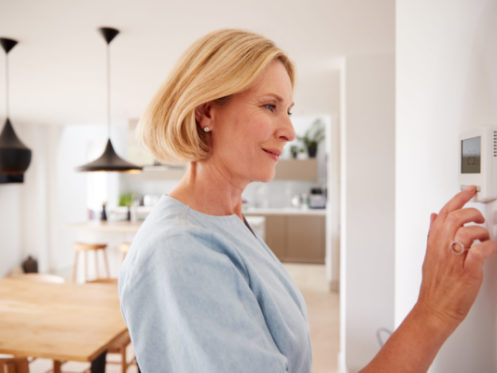Many homeowners wonder what the perfect temperature for their homes is, and the answer is that it depends. One of the factors is the season, but it also comes down to your personal preferences, specific goals, and finding the right balance between comfort and energy efficiency.
Winter While Home and Awake
The U.S. Department of Energy (DOE) recommends setting your thermostat to 68 degrees Fahrenheit while you are home and awake during winter. This temperature strikes the optimal balance between efficiency and comfort, but be mindful that you do have some latitude here. If you run hot or are snuggled up under some blankets watching a movie, lowering the temperature as far as 62 degrees is fine. If, on the other hand, 68 degrees feels too cold, you should first try wearing warmer clothing around the home. If that doesn’t work, experts advise that a temperature as high as 72 degrees Fahrenheit is reasonably efficient.
Winter While Sleeping or Away
The DOE estimates that the average household can reduce its heating bill by 5-15% if the temperature is lowered 10-15 degrees for a period of eight hours. If you work or attend school away from home, you have two periods in which you can make a significant difference in your heating bill. A temperature as low as 55 degrees Fahrenheit is safe while you are at work or on vacation, and a smart thermostat makes such a low temperature more practical because it can bring your home up to a comfortable temperature in advance of your return. While sleeping, the temperature recommendation is as low as 60 degrees.
Spring
A hard guideline for spring is trickier since it is a transitional season. In many climate zones throughout the U.S., spring is an opportunity to not use your heating and cooling system at all and to allow in some fresh air. If you do need to operate your heat earlier in spring, adhere to the guidelines for summer. Likewise, if you need to turn on the air toward the end of spring, follow the winter guidelines.
Summer While Home and Awake
The DOE created a stir online when it announced its most recent temperature guidelines, in particular a 78-degree recommendation for summer while home and awake. According to the DOE, this setting will limit your air conditioning costs and minimize your carbon footprint while keeping your home at a temperature that most people find comfortable. The internet was surprised as at least a vocal portion of it prefers a much cooler temperature, and experts responded that a temperature as low as 72 degrees Fahrenheit is all right. However, the DOE went on to suggest that you should lower the temperature incrementally to find your sweet spot as every degree above 72 degrees will make a real difference in emissions and your cooling costs.
Summer While Sleeping or Away
Most experts agree that a temperature as high as 85 degrees Fahrenheit is safe for your home while you are at work or away on vacation. You may be tempted to turn your air conditioner off entirely, but a number of construction trade associations in North America recommend against this action because high temperatures and humidity cause damage to drywall and wood over time. As for what temperature to set for sleep, that is an even more interesting discussion as there is disagreement. Energy experts advise between 72-78 degrees whereas some sleep specialists advise temperatures as low as 60 degrees Fahrenheit.
Autumn
Fall is similar to spring because it is a transitional period; much of the time, you may not run your heating and cooling systems and even have the windows open. When you do need to turn on the heat or the air conditioner, follow the recommendations we provided for winter and summer.
Ideal Temperatures for Infants and Toddlers
There are some caveats to the recommendations provided earlier that depend on the makeup of your household. This is particularly true for parents; medical professionals who specialize in infants and toddlers recommend temperatures no lower than 65 and no higher than 74 degrees Fahrenheit. Beyond the toddler phase, children are just like adults when it comes comfortable and safe temperatures. However, they do tend to run hot, so doctors advise listening and adjusting based on how they feel.
Ideal Temperatures for Pets
While away from your home, such as at work or school, you will need to take different precautions if you have pets at home. For the purposes of this discussion, we will focus specifically on dogs and cats, and experts suggest that a range of 64 to 78 degrees Fahrenheit is just fine for them. That means that you will likely need to run your AC more in summer and run your heating system more in winter.
Ideal Temperatures for Sleep
According to WebMD, most sleep doctors agree that the ideal sleeping temperature is between 60 to 67 degrees Fahrenheit. This range is relatively easy to achieve in winter. It is more difficult in summer, but if you have a smart thermostat, an option you have is setting the temperature as low is as needed to fall asleep and then having the system raise it up 67 degrees later in the night. An ideal temperature does vary from person to person, and if you want to be more precise about it, you will likely need to participate in an overnight sleep study.
Ideal Temperatures for Houseplants
When it comes to houseplants, be mindful that each species has different requirements. As a general rule, between 60 to 75 degrees Fahrenheit is ideal. However, most experts agree that setting your home to 85 degrees while at work or on vacation is beneficial if the plants are receiving regular care; likewise, most houseplants can withstand temperatures as low as 50 degrees.
Ceiling Fans
Experts recommend installing ceiling fans in all rooms where it is practical. While these fans do not actually make your cooler or warmer, they do help distribute air more evenly and help you to feel warmer in winter at a lower temperature and, in particular, cooler in summer at a higher temperature.
Dehumidification and Humidification
Portable or whole-home humidifiers and dehumidifiers can help as well. The reason is that relatively humidity shapes how you perceive temperature. Many people who are uncomfortable at 78 degrees Fahrenheit are just fine at that temperature when the relative humidity is no higher than between 50% and 60%.
Machine-Learning Thermostats
A smart thermostat that is able to learn and make recommendations or automatic adjustments is a powerful tool. The DOE suggests that the average home can save at least 10% on heating and cooling costs with a programmable thermostat, and a learning thermostat can increase those savings to 30% or more.
Your Local Thermostat Pros in Sacramento
Huft Home Services is proud to have served Sacramento and the surrounding areas since 2004, and we offer cooling, heating, plumbing, and electrical services in addition to home performance inspections, insulation installation, and indoor air quality assessments and equipment installations. Call Huft today, or contact us online to schedule an appointment or to ask questions about our products and services.



